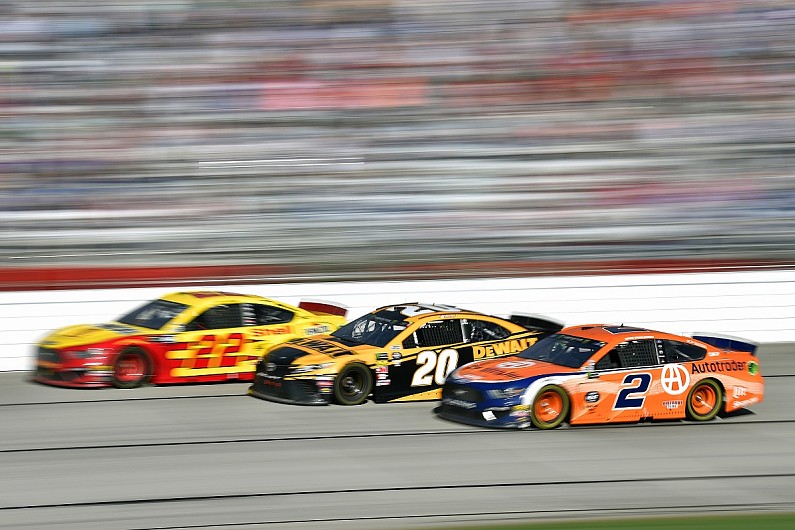Get unlimited access for free
You have only 5 articles remaining to view this month.
Last weekend’s NASCAR Cup race at Atlanta provided the first proper look at the series’ new rules package for 2019.
Headlining the changes is a major decrease in power, as well as larger splitters and spoilers. The latest in what feels like a never-ending stream of changes was brought in to create closer racing.
The aero changes, which add both downforce and drag, are intended to close up the field and make passing easier.
Reducing power will help with that too, making drivers work the throttle more; and by removing restrictor plates from superspeedway races for the first time since 1987, having a more consistent engine package over the course of the season in coming years could have the knock-on effect of enticing more manufacturers to enter NASCAR.
Air ducts will also be added to the cars for 16 of the races at tracks over 1.5 miles in length, with the race at Atlanta, as well as both Pocono events, the Darlington and Homestead races, and the Daytona 500 (which ran to the old restrictor plate rules) being the only exceptions.
On the face of it, the changes worked. The Daytona 500, the farewell for the old rules package, featured 15 lead changes among nine drivers, while Atlanta had 11 more lead changes among the same number of drivers over a shorter distance.
Of course, with Daytona and Atlanta being polar opposites in terms of pretty much everything, the basic numbers don’t tell the whole story.
Ahead of this season, 2015 Cup champion Kyle Busch showed his displeasure regarding the new package, saying: “We’ve taken the driving skill away from the drivers with this package. He also argued that it would make passing more difficult.
“When you get closer to the car in front of you, you’re drafting off of him because it’s helping you, then you get within a car length of him and it starts to push him away,” he told reporters at a pre-season test at Las Vegas. “There’s just not enough draft effect.”
“Anyone can go out and run wide open. It’s a lot more of a mental game, a lot more chess match thinking, how you’re going to make moves and how daring you be in making some of those moves, and how hard a time the guy you’re trying to pass is going to give you back.”
Busch’s remarks somewhat predicted how the race at Atlanta panned out. There was plenty of side-by-side racing in the field, with the lower horsepower engines hindered by the new ‘tapered spacer’ suffering from slower throttle response meaning momentum became a key factor in whether passes paid off or not. Out front though, the driver in the lead was often alone.
Roger Penske, whose three drivers all led portions of the race and who won with Brad Keselowski, was more positive in his assessment of the package, saying that NASCAR’s aims to close up the field had worked.
“There were drivers [that] could come from the back and come up so they could pass cars,” said Penske. “I thought the one thing that was amazing to me was [that] someone on the high line could run the low line going into [Turn] 2 and stay with them and drag them back going down the straightaway.
“The cars seemed to be more in control. It wasn’t a crash fest, which everybody said it was going to be potentially. It looks like there’s a lot of equal cars running out there. It’s going to come up to the drivers and the strategy, which is what we want.”

While Atlanta provided a good first indication of the direction NASCAR is going in, race winner Keselowski was quick to point out that it might not necessarily play out in the same way at other tracks due to Atlanta’s unique characteristics and punishing surface.
“It’s still really early,” he said. “Atlanta is not like the other mile-and-a-halfs in a lot of ways.
“A lot of tyre wear here, super high speeds and banking, super high tyre wear. It kind of maxes out in all the categories, and a Las Vegas next week is probably the middle of all the categories.
“I wouldn’t maybe guarantee that what you saw today is what you’ll see moving forward, for good or bad. So, it’s hard to give great answers, but all in all, I thought it was about what I expected it to be for Atlanta.
“But we’ll just keep tweaking on the cars, keep learning about them and keep getting better, and the racing will evolve. What direction, I don’t know.”
Atlanta was a story of restarts – the racing was extremely close each time the green flag dropped, but the field then spread out. For Las Vegas, there are already predictions of this weekend’s race panning out like Atlanta’s restarts, but over the course of 267 laps rather than just one or two.
With the first six races of the year taking place at six very different facilities – with Phoenix, Fontana, and Martinsville following Las Vegas – perhaps the only true assessment of NASCAR’s new rules package will come when the regular season wraps up towards the end of the summer.
